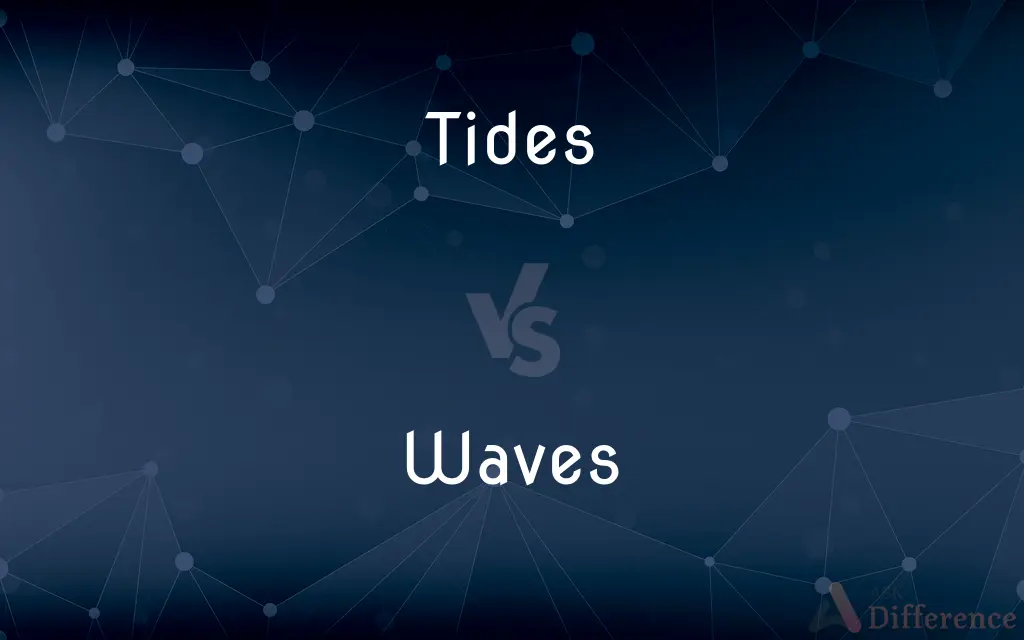Tides vs. Waves — What's the Difference?
By Tayyaba Rehman — Published on December 18, 2023
Tides are the periodic rise and fall of sea levels caused by the gravitational forces of the moon and sun, while waves are disturbances on the water surface caused by wind, seismic activity, or other forces.

Difference Between Tides and Waves
Table of Contents
ADVERTISEMENT
Key Differences
Tides and waves are both phenomena observed in bodies of water, particularly in oceans and seas. Tides are primarily influenced by the gravitational interactions between the Earth, moon, and sun. These interactions lead to the periodic rising and falling of sea levels. Waves, on the other hand, are disturbances that travel through the water, originating from various sources such as wind, seismic activities, or even passing ships.
Both tides and waves can have a significant impact on coastal regions. While tides can lead to flooding, especially during high tide, waves can cause erosion along coastlines. However, the way they operate and manifest is distinctly different. Tides follow a predictable cycle based on the positions of the moon and sun relative to Earth. Waves, however, can vary in frequency, amplitude, and direction depending on the driving force behind them.
It's fascinating to observe that while tides are a slow, rhythmic change in sea level, waves can be fast, short-lived, and sometimes even chaotic. Tides can change the depth of the water at any given location by several meters, influencing marine life and human activities. Waves, being more transient, can have immediate effects such as creating surfing conditions or contributing to storm surges.
Understanding both tides and waves is crucial for various fields, from marine biology to civil engineering. For marine creatures, tides can determine feeding patterns, mating behaviors, and other activities. For humans, understanding tides can aid in navigation, fishing, and construction along coastlines. Conversely, waves play a pivotal role in shaping beaches, influencing oceanic currents, and even harnessing energy for human use.
In essence, while tides and waves are integral to the dynamics of our oceans, they stem from different causes, manifest differently, and influence both marine life and human activities in unique ways.
ADVERTISEMENT
Comparison Chart
Cause
Gravitational interactions of Earth, moon, and sun.
Wind, seismic activity, or other forces.
Predictability
Highly predictable based on astronomical factors.
Varies based on driving force.
Frequency
Periodic, often twice daily.
Can be frequent and variable.
Impact on Shoreline
Can lead to flooding, affects marine life activities.
Causes erosion, affects surfing conditions.
Speed & Duration
Slow, rhythmic changes in sea level.
Fast, transient disturbances on water surface.
Compare with Definitions
Tides
Influenced by gravitational forces of the moon and sun.
The alignment of the Earth, moon, and sun results in spring tides.
Waves
Disturbances on the water surface.
The wind created strong waves, making it unsafe for small boats.
Tides
Affect marine life and human activities.
Fishermen often check tidal charts to determine the best fishing times.
Waves
Caused by wind, seismic activity, or other forces.
Earthquakes can generate massive tsunamis or seismic waves.
Tides
Periodic rise and fall of sea levels.
Coastal areas experience tides daily due to the moon's gravitational pull.
Waves
Can vary in size, frequency, and direction.
The southern coast has bigger waves, ideal for surfing.
Tides
Can be categorized as high and low.
The town prepares for potential flooding during the high tides.
Waves
Play a role in shaping coastlines.
Continuous waves have led to significant erosion along certain beaches.
Tides
Predictable based on astronomical cycles.
Sailors have used tides for navigation for centuries.
Waves
Can be harnessed for energy.
Wave energy converters are being tested to provide renewable power.
Tides
The periodic variation in the surface level of the oceans and of bays, gulfs, inlets, and estuaries, caused by gravitational attraction of the moon and sun.
Waves
Plural of wave
Tides
A specific occurrence of such a variation
Awaiting the next high tide.
Tides
Flood tide.
Tides
Tidal force.
Tides
Something that increases, decreases, or fluctuates like the waters of the tide
A rising tide of skepticism.
The shifting tide of the battle.
Tides
A large amount or number moving or occurring in a mass
An incoming tide of immigrants.
A tide of angry letters.
Tides
A surge of emotion
Felt an irresistible tide of sympathy for the defendant.
Tides
A time or season. Often used in combination
Eventide.
Christmastide.
Shrovetide.
Tides
A favorable occasion; an opportunity.
Tides
To rise and fall like the tide.
Tides
(Nautical) To drift or ride with the tide
Tided off the reef.
Tiding up the Hudson.
Tides
To carry along with the tide.
Tides
To betide; befall.
Tides
Plural of tide
Common Curiosities
How often do tides typically occur?
Most places experience two high tides and two low tides daily, known as semidiurnal tides.
What primarily causes tides?
Tides are mainly caused by the gravitational forces of the moon and sun on Earth.
Why are waves different sizes?
Wave size varies based on the strength and duration of the wind, and the area over which it blows.
Can tides be predicted?
Yes, tides are highly predictable based on the positions of the moon and sun relative to Earth.
How do tides affect marine life?
Tides can influence feeding, mating, and migration patterns of various marine species.
Can waves be used for energy?
Yes, wave energy converters can harness the kinetic energy of waves for power.
Are tidal waves and tsunamis the same?
No, "tidal wave" is a misnomer; tsunamis are large ocean waves caused by underwater seismic activity.
What are the main factors that create waves?
Waves are primarily formed by wind, but can also be caused by seismic activity and other disturbances.
What is a "storm surge"?
A storm surge is a rise in sea level due to low atmospheric pressure and wind associated with a storm.
Why do tides vary in magnitude?
Tidal magnitude varies due to factors like the moon's position, Earth's shape, and local geographical features.
How do waves affect coastal regions?
Waves can cause erosion, shape coastlines, and influence local ecosystems.
Can tides influence the weather?
Indirectly, tides can affect ocean currents, which in turn can influence weather patterns.
What is a "wave height"?
Wave height is the distance from the crest (top) of a wave to its trough (bottom).
Can waves travel across entire oceans?
Yes, waves, especially those from large disturbances like tsunamis, can travel across entire ocean basins.
What's the difference between spring tides and neap tides?
Spring tides occur when the sun, moon, and Earth align, causing higher tidal ranges, while neap tides occur when they form a right angle, causing lower tidal ranges.
Share Your Discovery

Previous Comparison
Classical Tragedy vs. Modern Tragedy
Next Comparison
Primary Market vs. Secondary MarketAuthor Spotlight
Written by
Tayyaba RehmanTayyaba Rehman is a distinguished writer, currently serving as a primary contributor to askdifference.com. As a researcher in semantics and etymology, Tayyaba's passion for the complexity of languages and their distinctions has found a perfect home on the platform. Tayyaba delves into the intricacies of language, distinguishing between commonly confused words and phrases, thereby providing clarity for readers worldwide.
















































